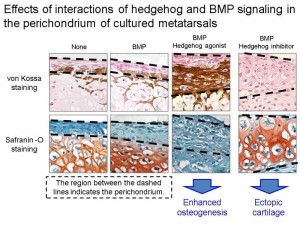Perichondrial cell fate specification mechanisms Hedgehog and BMP signaling interact in osteoblast and chondrocyte specification


© Hironori Hojo. Effects of the interaction of hedgehog and BMP signaling on bone and ectopic cartilage formation in the perichondrium. When hedgehog signaling was activated, activation of BMP signaling enhanced bone formation. On the other hand, when hedgehog signaling was suppressed, activation of BMP signaling induced ectopic cartilage formation instead of bone formation.
Progenitor cells are known to exist in our body and differentiate into several cells. One type of such cells, termed osteo-chondroprogenitors, is suggested to reside in the perichondrium, a thin layer of fibroblastic tissue surrounding the cartilage mold, and contribute to bone formation during bone development in embryos. During development, the cells in the perichondrium differentiate into osteoblasts to form bone tissue, while they have been shown to form cartilage tissue in mice deficient in certain genes. It has been proposed that the specification process of the perichondrial cells is regulated by several growth factors including hedgehog and BMP signaling; however, the detailed molecular mechanisms underlying the process are not fully understood.
Dr. Hironori Hojo (JSPS Research Fellow, The University of Tokyo Graduate School of Medicine, University of Southern California Broad-CIRM Center), Project Associate Professor Shinsuke Ohba, and Professor Yuichi Tei/ Ung-il Chung (Department of Bioengineering, The University of Tokyo Graduate School of Engineering), collaborating with Drs. Hideki Kambara (Fellow, Hitachi Central Research Laboratory) and Yuji Mishina (Associate Professor, School of Density, University of Michigan), found that interactions of hedgehog and BMP signaling were involved in the specification of the osteo-chondroprogenitors in the perichondrium. This finding will contribute to the development of regenerative strategies for bone and cartilage defects using hedgehog and BMP.
Paper
Hironori Hojo, Shinsuke Ohba, Kiyomi Taniguchi, Masataka Shirai, Fumiko Yano, Taku Saito, Toshiyuki Ikeda, Keiji Nakajima, Yuske Komiyama, Naomi Nakagata, Kentaro Suzuki, Yuji Mishina, Masahisa Yamada, Tomohiro Konno, Tsuyoshi Takato, Hiroshi Kawaguchi, Hideki Kambara, and Ung-il Chung,
“Hedgehog-Gli activators direct osteo-chondrogenic function of bone morphogenetic protein toward osteogenesis in the perichondrium”,
Chemistry, Vol: 288, Year: 2013, page: 9924-9932 , April 5, 2013 doi: 10.1074/jbc.M112.409342.
Article link
Links
Graduate School of Engineering
Department of Bioengineering, Graduate School of Engineering
Skeletal Development and Regeneration Research Group, Tei/Chung Laboratory







